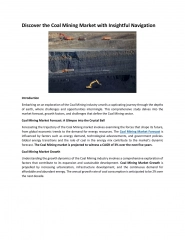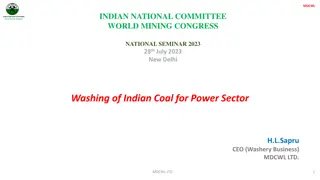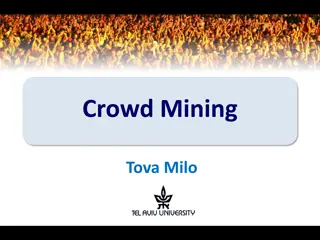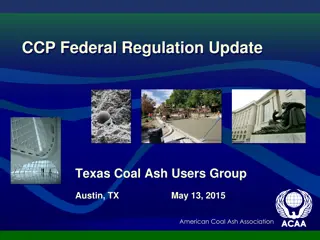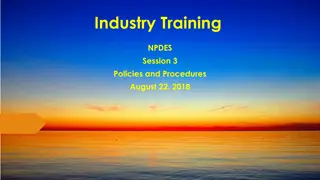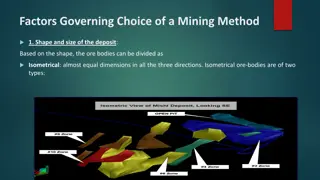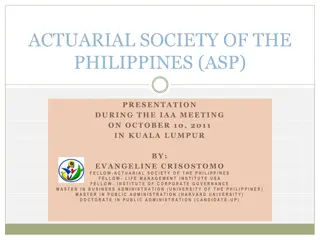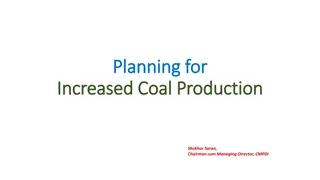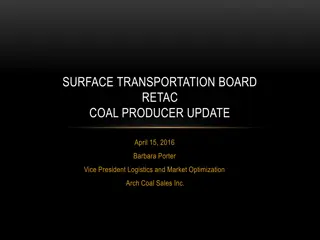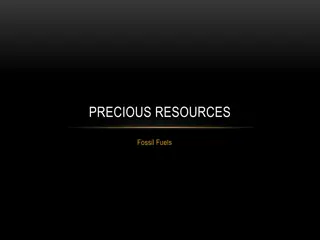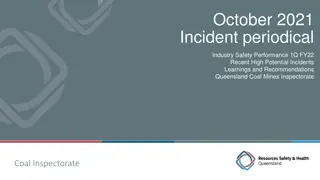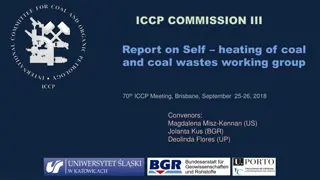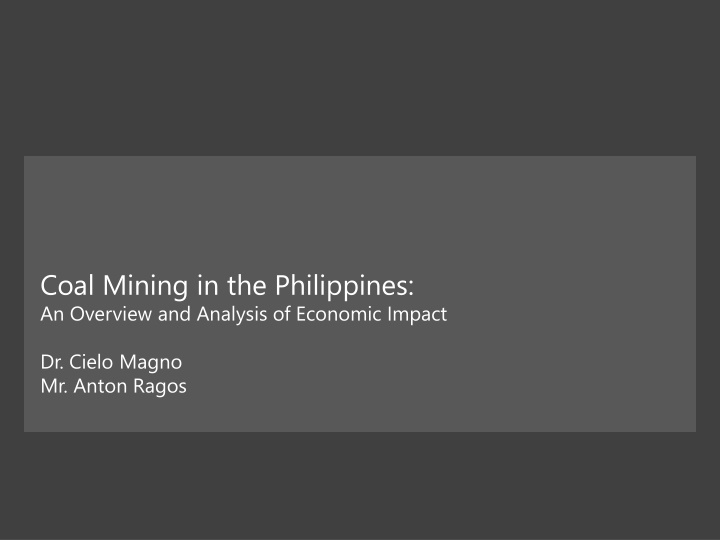
Economic Impact of Coal Mining in the Philippines
This overview and analysis cover coal reserves, production, demand, and consumption trends in the Philippines, highlighting the economic implications. Explore the data on mineable coal reserves, production shares, and industry-specific consumption patterns.
Download Presentation

Please find below an Image/Link to download the presentation.
The content on the website is provided AS IS for your information and personal use only. It may not be sold, licensed, or shared on other websites without obtaining consent from the author. If you encounter any issues during the download, it is possible that the publisher has removed the file from their server.
You are allowed to download the files provided on this website for personal or commercial use, subject to the condition that they are used lawfully. All files are the property of their respective owners.
The content on the website is provided AS IS for your information and personal use only. It may not be sold, licensed, or shared on other websites without obtaining consent from the author.
E N D
Presentation Transcript
Coal Mining in the Philippines: An Overview and Analysis of Economic Impact Dr. Cielo Magno Mr. Anton Ragos
Coal Reserves Mineable Coal Reserves, as of Dec. 2012 Semirara 101.91 C. Valley 70.18 S. Cotabato 48.64 Surigao 47.55 Zamboanga 22.79 Samar 7.28 Cebu 6.97 PBC 3.61 Negros 1.21 Mindoro 0.87 Davao 0.12 Quezon 0.06 Masbate 0.04 0.00 20.00 40.00 60.00 80.00 100.00 120.00 Mineable Coal Reserves, by area, (in million metric tons) as of Dec. 2012 Source: Energy Resource Development Bureau, Department of Energy
Coal Production Production share based on mining areas, 2013 5.53% 94.47% Semirara Island Other Areas Cebu 0.84 Surigao 0.76 Zamboanga 0.35 Albay 0.29 SSMC 1.36 0 0.5 1 1.5 Market Share of Other Areas, including small-scale mining contractors (in %) Source: Energy Resource Development Bureau, Department of Energy
Coal: Demand and Supply Coal production, importation, and consumption, (in million metric tons) 1977-2012 25 20 15 10 5 0 1977 1978 1979 1980 1981 1982 1983 1984 1985 1986 1987 1988 1989 1990 1991 1992 1993 1994 1995 1996 1997 1998 1999 2000 2001 2002 2003 2004 2005 2006 2007 2008 2009 2010 2011 2012 Production Importation Source: Department of Energy
Coal: Demand and Supply Coal production, importation, and consumption, (in million metric tons) 1977-2012 25 20 15 10 5 0 1977 1978 1979 1980 1981 1982 1983 1984 1985 1986 1987 1988 1989 1990 1991 1992 1993 1994 1995 1996 1997 1998 1999 2000 2001 2002 2003 2004 2005 2006 2007 2008 2009 2010 2011 2012 Production Importation Consumption Source: Department of Energy
Coal: Demand and Supply Coal consumption, by industry, (in %) 2009-2012 4.83 3.86 4.14 5.96 16.95 (mmmt) 14.23 (mmmt) 19.81 21.8 13.31 (mmmt) 12.06 (mmmt) 23.42 75.35 18.79 74.33 72.44 75.24 2009 2010 2011 2012 Power Generation Cement Production Other Industrial Processes* *Include: alcohol, sinter, rubber boots, paper and chemical manufacturing, fertilizer production, and smelting processes Source: Department of Energy Kessels, John (no date), Prospects of Coal and Clean Coal Technologies in the Philippines
Coal: Electricity Generation Electricity generation , by source (in GwH), 1980- 2010 80000 70000 60000 50000 40000 30000 20000 10000 0 1980 1981 1982 1983 1984 1985 1986 1987 1988 1989 1990 1991 1992 1993 1994 1995 1996 1997 1998 1999 2000 2001 2002 2003 2004 2005 2006 2007 2008 2009 2010 Renewable Oil Natural Gas Hydroelectric Coal Source: World Bank
Coal Development Act of 1976 Presidential Decree 972, as amended by Presidential Decree 1174 Promotes accelerated exploration, development, exploitation, production, and utilization of coal Introduces the Coal Operating Contract (COC) system Assigns the operator to conduct the exploration, development, exploitation, and marketing of coal resources Sets out obligations of operators, and incentives to coal operators and end-users Source: Presidential Decree 972
Coal Operating Contract Exploration Phase and Development and Production Phase Exploration Phase: Two (2) year period Two (2) year allowable extension (maximum) Development and Production Phase: Remaining period of Exploration Phase and/or Ten (10) year period (additional) Ten (10) year allowance extension (maximum) Series of three (3) year allowable extensions not exceeding a total of twelve (12) years Source: Presidential Decree 972, as amended Coal Model Contract
Coal Operating Contract Incentives and Privileges Exemption from all national taxes except income tax Exemption from payment of duties on machinery/equipment importation Recovery of Operating Expense Entry of foreign technical personnel Preference in grant of government loans* Accelerated Depreciation* *incentives not set out in the COC but are specified in PD 972 as amended Source: Presidential Decree 972, as amended Coal Model Contract
Coal Operating Contract Revenue-Sharing Scheme Gross Proceeds Less: Recoverable Cost 100.00 90.00 Net Proceeds Less: Basic Fees Special Allowances 10.00 4.00 3.00 Government Share Department of Energy Local Government Unit 3.00 1.80 Gov t Share Recoverable Cost Basic Fee Special Allowance 1.20 Source: Presidential Decree 972, as amended Coal Model Contract Coal Operating Contract Accounting Procedure
Local Government Code of 1991 Utilization of LGU share Local government units shall receive 40% of gross collection from mining taxes Divided between province (20%), municipality (45%), and barangay (35%) At least 80% of the said fund shall be used to lower cost of electricity Remaining amount shall be used for local livelihood projects Source: Presidential Decree 972, as amended Coal Model Contract
Coal Operating Contract Revenue-Sharing Scheme Gross Proceeds Less: Recoverable Cost 100.00 90.00 Net Proceeds Less: Basic Fees Special Allowances 10.00 4.00 3.00 Government Share Department of Energy Local Government Unit 3.00 1.80 Gov t Share Recoverable Cost Basic Fee Special Allowance 1.20 Source: Presidential Decree 972, as amended Coal Model Contract Coal Operating Contract Accounting Procedure
Environmental Regulation General Provisions Subject to the Environmental Impact System (EIS) of the Department of Energy and Natural Resources. Outside the scope of EIS, coal operators are required to: Rehabilitate affected sites after contract termination Render comprehensive anti-pollution reclamation plan Follow government guidelines on: mining procedures to minimize environmental damage; water waste control; erosion control; and re-vegetation Source: Coal Model Contract
Semirara Mining Corporation Coal Revenue, Cost of Sales, and Government Share, (in million PhP) 2004-2012 18000 16000 14000 12000 10000 8000 6000 4000 2000 0 2004 2005 2006 2007 2008 2009 2010 2011 2012 Government Share Net Revenue Cost of Sale Source: Semirara Mining Corp. Consolidated Financial Statements, 2006-2012
Semirara Mining Corporation Income Tax (in million PhP), Statutory and Actual Income Tax Rate (in %) 2004-2012 450.0 400.0 422.6 350.0 327.5 300.0 309.2 250.0 237.0 200.0 150.0 100.0 50.0 49.7 -4.7 -16.4 0.0 63.3 11.5 -50.0 2004 2005 2006 2007 2008 2009 2010 2011 2012 Statutory 32.00 32.50 35.00 35.00 35.00 30.00 30.00 30.00 30.00 Effective 3.34 20.97 33.96 34.06 22.94 3.32 -0.90 -0.36 0.62 Source: Semirara Mining Corp. Consolidated Financial Statements, 2006-2012
Semirara Mining Corporation Foregone Revenue from the Income Tax Exemption (in million PhP), 2008-2012 2500 1,917.40 2000 1,834.55 1500 1,219.92 1000 584.81 500 118.43 0 2008 2009 2010 2011 2012 Statutory Exemption 35.00 11.46 30.00 30.62 30.00 31.14 30.00 30.68 30.00 29.97 Source of basic data: Semirara Mining Corp. Consolidated Financial Statements, 2006-2012
Economic Impact Poverty incidence in localities of coal operation Cauayan City Gattaran Iguig Tandag Compostela Danao City Bislig Lianga Balamban Calatrava Buug Malangas Imelda Diplahan Caluya Marihatag San Miguel Bulalacao Lake Sebu Dalaguete Rapu-Rapu Payao 0 10 20 30 40 50 60 70 Provincial Poverty Incidence Municipal/City Poverty Incidence National Poverty Incidence Notes: Dalaguete has three (3) contract operators Rapu-Rapu has four (4) contract operators Gattaran, Iguig, Danao City, Imelda, San Miguel, and Payao have two (2) contract operators, respectively Source: Department of Energy
Economic Impact Regression Analysis: Descriptive Statistics Variable Obs. 42,583 42,732 42,732 42,732 42,732 42,732 42,732 42,732 42,732 42,732 42,732 42,732 42,732 42,732 42,732 42,732 42,732 42,732 42,732 42,732 Mean 107,009.70 0.02 1.65 0.03 0.21 0.19 0.12 0.08 0.11 0.24 0.25 0.06 0.05 0.02 0.20 0.04 0.05 0.07 0.01 0.02 Std. Dev. 135,336.80 0.35 6.07 0.17 0.41 0.39 0.32 0.27 0.32 0.25 0.43 0.24 0.21 0.14 0.40 0.20 0.21 0.26 0.08 0.13 Min. 1,942.00 0.00 0.00 Max. HH Total Income Coal share of province (%) Share from other nat l tax collection (%) HH head educ (none) HH head educ (elem. undergrad) HH head educ (elem. grad) HH head educ (HS undergrad) HH head educ (college undergrad) HH head educ (college grad) HH members wage-earners (%) Earns from farming and gardening Earns from poultry and livestock Earns from fishing Earns from forestry and hunting Earns from wholesale and retail Earns from manufacturing Earns from social, community services Earns from transportation Earns from construction Earns from entrepreneurship 4,286,302.00 5.47 56.69 0.00 1.00
Economic Impact Regression Analysis: Results HH Total Income Coal share of province (%) Share from other nat l tax collection (%) HH head educ (none) HH head educ (elem. undergrad) HH head educ (elem. grad) HH head educ (HS undergrad) HH head educ (college undergrad) HH head educ (college grad) HH members wage-earners (%) Earns from farming and gardening Earns from poultry, livestock raising Earns from fishing Earns from forestry and hunting Earns from wholesale and retail Earns from manufacturing Earns from social, community services Earns from transportation Earns from construction Earns from entrepreneurship (Constant) *significant at 1% Coefficient -4,420.27* -10.44 -52,340.7* -44,592.1* -32,630.9* -28,808.1* 32,175.5* 136,175.6* 516.844* -2,023.4 -1,082.14 -1,639.14 -13,289.1* 27,301.35* 7,609.863* 42,635.01* 19,551.73* 92,968.28* 82,033.83* 87,991.64* Robust Std. Err. 1,245.47 84.00 1,608.27 1,232.01 1,278.75 1,477.81 2,821.99 3,711.40 29.02 1,265.22 1,838.96 2,564.52 2,313.41 1,814.09 2,461.89 4,552.18 2,629.76 31,020.83 12,342.07 1,496.28
Conclusion Coal mining operation remains small in some areas Earmarking for electrification leads to spending constraint among LGU s Government is subsidizing coal operation Existing laws are silent in terms of absorbing negative externalities of coal mining Coal mining has negative impact on household income

